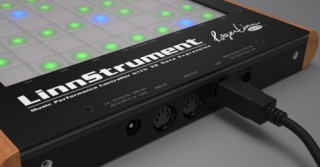In this video, inventor Roger Linn gives a concise introduction to the LinnStrument – a recently released MIDI controller that supports 3 dimensions of expression, for each note that you play.
Since the LinnStrument is a MIDI controller, it can be used with any MIDI software and hardware. But it also can be used to control a growing number of MIDI synths that support Multidimensional Polyphonic Expression (MPE).
MPE is a new specification for communicating this wider range of polyphonic expression, in a way that is compatible with MIDI 1.0. The need for it arises from the fact that MIDI controllers have traditionally been capable of a more limited range of per-note expression, usually note on/off messages and velocity.
As more capable controllers have become available, including the LinnStrument, Haken Continuum, KMI QuNexus amd the Madrona SoundPlane, there is a growing need for a consensus on how to interpret the rich polyphonic MIDI information that these instruments can generate, and MPE is designed to address that need. The LinnStrument firmware was updated earlier this year to support MPE.
 The LinnStrument is designed to capture three dimensions of expression for each note played:
The LinnStrument is designed to capture three dimensions of expression for each note played:
- Velocity and finger pressure (Z axis) is typically used to vary note loudness, like traditional MIDI controllers. While most MIDI controllers capture velocity, and some channel-aftertouch, the LinnStrument captures finger pressure polyphonically.
- Finger left-right (X axis) movement is used to vary pitch, both discretely, like a traditional control keyboard, and continuously.
- Finger forward-backward (Y axis) movement is used to vary timbre. Most control keyboards are limited to a mod wheel, which modifies all voices. The LinnStrument allows for per-voice modulation.
The LinnStrument is available via Roger Linn Design for US $1,499.

This is a great instrument , i gat two and i really enjoy them , a great way to play music with expression and feeling . I should say the best way
I am enjoying mine quite alot as well. It’s very expensive but the keybed feels really really playable.
It really does feel like its own instrument and makes it easy to create playable and musical sounds you wouldn’t play on a keyboard.
There are still a limited number of synths that take advantage of what it can do
Wonderful. Thanks for this creation. I want one. It will integrate well with my iOS based setup. Are you listening Father Christmas?